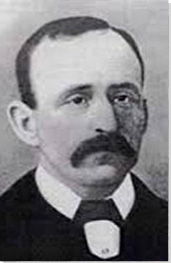Summary of Alfred Wallis
Alfred Wallis's exuberant seascapes and nautical scenes muster all the energy and verve of modern art, with their expressionistic use of shape, color, and brushstroke, and their multi-focal perspectives. It is all the more striking, then, that Wallis had no formal training, and that the qualities which make his work seem inventive and daring simply express his instinctive feel for his subject matter. Wallis spent his life as a mariner, travelling across the Northern Atlantic, before settling in the small Cornish town of St. Ives to see out his days as a scrap merchant and, ultimately, a poor house inmate. By this time the St. Ives School of modern artists had become enamored of his work - Wallis's paintings must now be a central feature of any discussion or presentation of the group's achievements. That Wallis remained guarded and aloof about their interest in him isevidence of his single-minded approach to his craft.
Accomplishments
- Alfred Wallis in many ways provides the blueprint for our modern understanding of the "outsider artist", an untutored creative spirit whose gift is seen as the product of instinct rather than learning. Around the time that Wallis was "discovered" by Ben Nicholson, other outsider artists were being 'studied' in Europe, such as the mental asylum inmate Adolf Wölfli. The concept of outsider art was formalized by Jean Dubuffet after the Second World War through the term Art Brut (raw art), but much of what Dubuffet proclaimed had been predicted by the St. Ives artists' celebration of Wallis.
- Wallis's paintings show a kind of instinctive Expressionism. Without any conventional formal artistic training, Wallis had no ingrained sense of how objects might be positioned in relation to each other to recreate three-dimensional space, or of how to maintain one implied viewing position across a whole canvas. This meant he was free to present objects and scenes in ways which expressed their emotional and thematic significance to him, and to use multiple perspectives in the same painting. All this is highly reminiscent of the 'form-follows-feeling' approach of the Expressionist movement defined in the early twentieth century.
- Wallis is often spoken of as a member of the St. Ives School. This was a group of modern artists, including Barbara Hepworth, Ben Nicholson, Christopher Wood, and the Russian émigré Naum Gabo, who settled in the Cornish fishing village of St. Ives in the 1930s. Together they developed a kind of organic modernism, applying the formal traits of Constructivism, Cubism, and modern sculpture to the natural subject-matter they found around them. Though Wallis never felt entirely comfortable in their midst, his work certainly inspired the early development of their work.
Important Art by Alfred Wallis
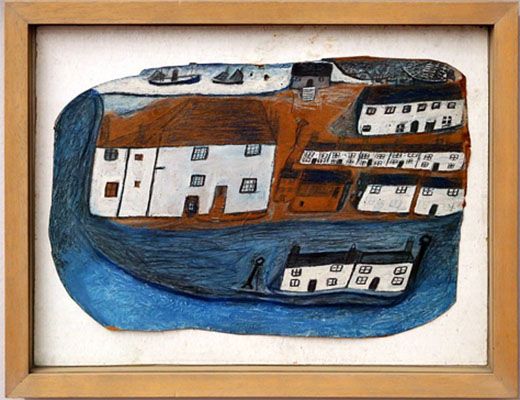
St. Ives
Curiously proportioned rows of houses dominate this early landscape work, showing Wallis's hometown of St. Ives. The houses are enclosed on three sides by a bay, the sweep of water around the harbor emphasized by scratched, painterly strokes. In the background, small ships are moored, while in the foreground a figure emerges from one of the houses. The shape of the cardboard on which the painting is produced echoes the curvaceous sweep of the harbor. This, along with the simple blue-and-brown color palette, gives the piece a subtle sense of visual harmony and energy.
While many of Wallis's paintings were produced from memory, and recall his former life at sea, he also produced a number of townscapes and harbor scenes. Though many have viewed Wallis as a mere naïf, there is an important element of thematic stylization in works such as St. Ives. The painting is not a true depiction of the town in the early-twentieth century, but an evocation of how Wallis remembered and idealized it. For Wallis, St. Ives was a community where a simple, self-sufficient life was possible. The idea - already waning in accuracy - that his prosperity as well as the town's was tied solely to the fishing industry is emphasized by the fact that Wallis has surrounded the scene with water. In the foreground the houses and figures even appear to be floating in the ocean. According to artist and biograher Sven Berlin, Wallis's St. Ives paintings tell the story "of men working in a well ordered community until it was squeezed out of existence by the gradual progress of modern politics and finance." Here Wallis has preserved his sense of the St. Ives that once was before modernization caused the local fishing industry to die away.
These images are therefore works of conscious imaginative construction, which sought to embody the kind of life that Wallis treasured. For Berlin, "Wallis' naïveté is not something just personal to himself; it is characteristic of the people he grew from." We might rather say that naivety was a quality he tried to cling to.
Oil paint, graphite and crayon on cardboard - Collection of the Tate, United Kingdom
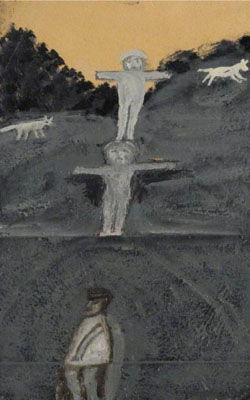
Crucifixion or Allegory with Three Figures and Two Dogs
Alfred Wallis's crucifixion scene is divided into two halves, possibly by a fold in the found material on which it was created. In the top half of the work, set against a dark landscape of trees, two figures in different shades of gray stand with arms outstretched, one behind the other - though they might also seem to be stacked into a column. On either side of the two cruciform figures white dogs are rendered mid-stride. In the bottom half of the painting, a man in white clothing with a dark grey hat, perhaps the owner of the dogs, walks past, seemingly oblivious to the scene above.
This painting partly evokes Wallis's religious beliefs. A devout Christian, he became completely absorbed in his faith after his marriage to Susan Ward in 1875, joining her in her allegiance to the Salvation Army. Wallis would read aloud from the family Bible in the evenings, and he refused to sell paintings on Sundays, seeing it as an act of sacrilege. At the same time, the image begs as many questions as it answers regarding both the content of Wallis's faith and the comfort that it brought him. The two figures in crucifixion shape, in combination with the presence of three figures overall, refers to the Holy Trinity, while the sense of emotional disconnect between the humdrum character below and the scene above suggests some sense of detachment from the salvation that faith might offer. Another interpretation might focus on the dark color scheme and the sense of foreboding generated by the circling, uncannily identical dogs. By this reading the painting could express Wallis's deteriorating mental health, characterized by the fear that he was being pursued by agents of the devil.
Whether it presents a positive or a negative expression of religious faith, Sven Berlin notes that "[Wallis's] paintings came into being from no other source than his own creative soul." The sense of mystery and doubt that the work generates is therefore an expression of the hope, loss, and confusion that shaped Wallis's own character and life.
Oil on card - Kettle's Yard, Cambridge
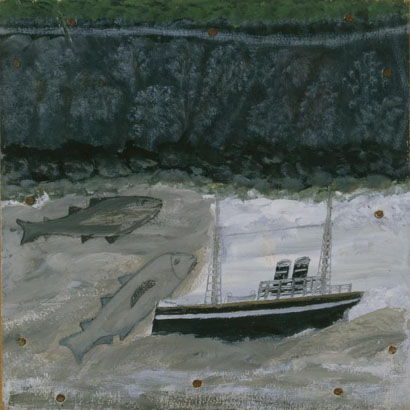
Land, Fish and Motor Vessel
The most arresting elements of this painting from the 1930s are the two enormous fish that circle around the motorized fishing vessel to the right. In the background is a stripe of green land, with barely visible trees rendered in light, feathery, white brushstrokes. The cliff face in the center of the picture appears to have been painted in two pigments which have not mixed, creating a mottled, marbled quality typical of Wallis's unusual textural effects.
This painting exemplifies Wallis's intuitive, expressionistic approach to form and composition. Classified as a "naïve" painter, he certainly lacked any institutional training, and was unhindered by a conventional sense of perspective. As such, objects seem to assume a size and position relative to their emotional or thematic significance, while perspective is specific to individual objects or sections within the frame. The fish thus assume the proportions appropriate to their importance for a mariner and member of a regional fishing community, and are presented front on rather than in accordance with the aerial perspective on the ocean. The apparent lack of distance between ship and shore, and the way that the flat landscape behind the water seems more vertical than horizontal, add to the overall impression of formal play.
The element of personal memory in these paintings is also significant. Wallis's paintings were drawn from his recollections of early life at sea, so what is glimpsed here is perhaps the relative scale with which objects and scenes loom in his retrospective imagining of that life. The large fish evoke something of the vast, prodigal, non-human life of the ocean, while the land may suggest the promise of return after each trip. In Wallis's case, then, lack of formal training in no way equates to a lack of depth or profundity.
Oil on card - Kettle's Yard, Cambridge
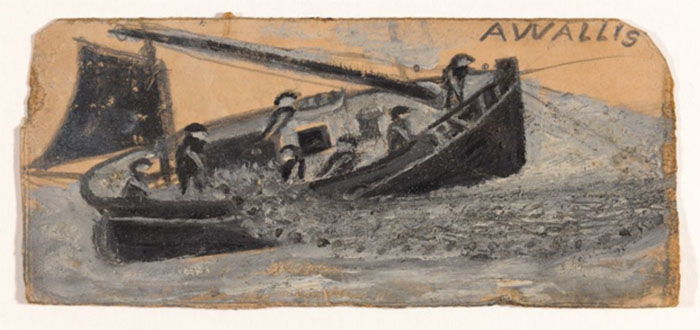
Boat with Fishermen Letting out Nets - PZ 11, the Flying Scud
In this evocative, undated work, a fishing boat with lowered mast and mainsail lets out a sheet of net into the water. Seven men are at work on board, surrounded by water which seems to rise up to the edge of the hull to the right of the vessel. The color scheme is grey and black, with the brown-shaded sky is the color of the card on which the work is painted.
Given the use of a visible painting surface and prominent signature, this work provides an evocative insight into Wallis's creative process. Having never bought a canvas - simply because they were too expensive - he would paint on any surface he could find around his house, including walls, pieces of wood, jars, covers of books, and, as in this case, scraps of card. While he was not the first artist to utilize such materials, the fact that he never primed or covered his surfaces allowed their natural textures and tones to show through on occasion, becoming integrated stylistic features of the work - somewhat in the style of Cubist collage or Kurt Schwitters's "Merz" objects and bricolage. For Wallis, however, such formal gestures were not consciously invested in an idea of "anti-art". It was simply that creating his paintings to get his memories recorded was more important than producing a refined work - though the very fact that he remained so true to this impulse even after being lauded by members of the modernist art world is itself remarkable.
This painting also alludes to a change in Wallis's biographical circumstances during the middle phase of his life. After many years as a deep-sea mariner, Wallis gave up his long voyages for work on local fishing boats. Here he has depicted the work involved in sustaining his life in St. Ives - as such, these works have a basis in more recent memory than those filled with ice floes and looming cliffs.
Oil on card - Kettle's Yard, Cambridge
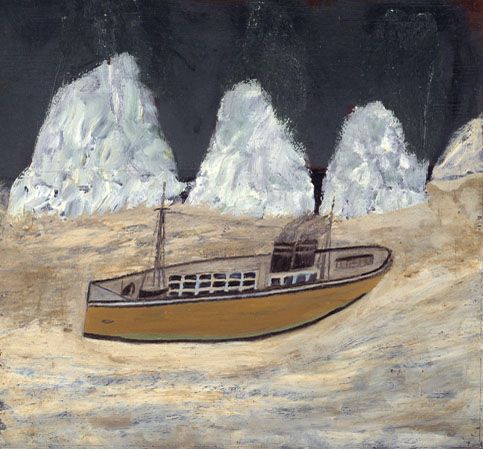
Voyage to Labrador
A large brown ship, set apart from its surroundings by a thick black outline, occupies the center of Voyage to Labrador. The vessel floats on an ocean rendered in shades of browns and grays. White rocks are set against a black background. The formal interest of the piece lies partly in the distinction between the smooth, seamless surface of the boat-hull and the painterly textures and roughly blended colors of the water and cliffs.
This work is an important example of the paintings Wallis created to record his memories of life at sea. Having worked on boats since the age of nine, he undertook many transatlantic journeys. This work, as its name suggests, is based on his many voyages from England to Labrador, in the Newfoundland province of Canada. These trips were completed during a period of Wallis's life when he was newly married, suddenly finding himself responsible for five stepchildren. As such, he needed the funds earned from these long deep-sea trips. Sven Berlin describes work on these Newfoundland ships as "particularly arduous. Sometimes in rough weather they were blown as far out of their course as South America, taking thirteen weeks to get home."
The foreboding tone of this work - the icy white rocks, and deep, gloomy water - may indicate the sense of isolation and trepidation which such voyages instilled in Wallis and his fellow mariners. At the same time, the sharply outlined boat seems to cut a course through this murky landscape with a certain intrepid vigor. The work is thus imbued with a subtle Romantic energy, alluding unconsciously to the sublime spirit of much nineteenth-century landscape painting.
Oil on plywood - Collection of the Tate, United Kingdom
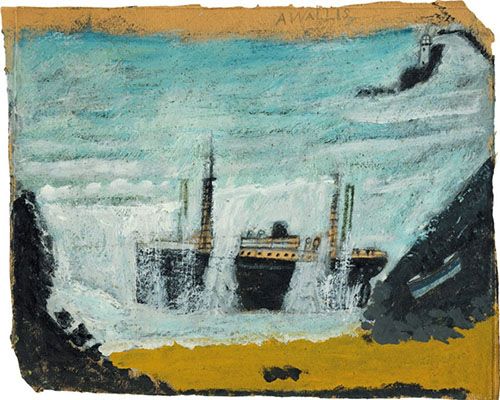
Wreck of the Alba
This late-1930s painting is a rare example of a work by Wallis not created solely from personal memory or imaginative reconstruction. Here we see a depiction a real event, the wreck of the SS Alba, a steamer ship bound for Italy that crashed off the coast of St. Ives on January 31st, 1938. A white, wave-filled sea dominates Wallis's frame, while in the foreground the Alba has run aground on a cusp of land, half submerged in surf. To the right is a lighthouse, perhaps included by Wallis for topical interest, since one explanation of the tragedy was that the local Godrevy Lighthouse had shone less brightly since its conversion to an unmanned light-source.
As a resident of St. Ives at the time of the disaster, it is possible that Wallis witnessed the wreck of the Alba firsthand. He was perhaps even part of the local rescue team, that saved all but five of the ship's crew after the lifeboat that had initially rescued them was itself overturned in the stormy sea. Wallis produced several paintings of the event, suggesting its significance both to his own life and that of his town.
The Tate's catalog entry on the piece suggests further symbolic resonances, noting that "Wallis's profound religiosity can be read in the epic struggle between man and nature." The notes also suggest that "omens of an encroaching national crisis are [...] hinted at in the word 'ALBIAN', etched on to the side of the embattled craft. A play on the name of the ship, it also directly evokes Albion, a name commonly used for Britain." While the work can thus be read as an allegory for the coming war, "[t]here is a sense too in which the painting speaks of Wallis's own mental turmoil in the late 1930s. The overwhelming force of the sea in Wreck of the Alba might [...] signify Wallis's own sense of becoming subsumed by the seemingly threatening world around him."
Oil paint on wood - Collection of the Tate, United Kingdom
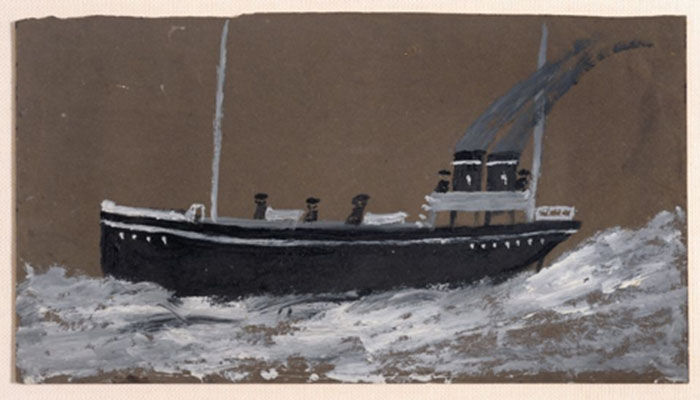
Death Ship
A large black ship with billowing dark gray steam is the focal point of Alfred Wallis's Death Ship. Five sailors, dressed in black suits and hats, are visible on the ship as it travels through an icy white ocean.
Aptly titled, this work is an important example of the kind of paintings Wallis made near the end of his life. Sven Berlin identifies these as his "death paintings." They reflect a time of deep sadness for the artist. Experiencing degenerating eyesight and significant mental deterioration, Wallis was creating these works in the throes of isolation. The exact time at which Wallis painted these final works is not confirmed. They were either made while Wallis was living in the Madron poorhouse or shortly before his institutionalization there, a fate he had long feared. The gloomy tone of the work, replete with black ship and darkly-clad figures, is emphasized by the deep brown tone of the card on which the painting is created.
Works like Death Ship give the lie to the idea that, as a "naïve" artist, Wallis was not capable of generating a powerful and complex degree of symbolism through his work. The ship, as well as being an amalgam of those Wallis had encountered during his life at sea and around the shorelines of St. Ives, is a portent of death and desolation, an allegorical rather than literal representation of his work's themes.
Oil on card - Kettle's Yard, Cambridge, England
Biography of Alfred Wallis
Childhood and Education
As a child, Alfred Wallis's life was shaped by absence and loss. His father, Charles Wallis, was a roadworker who was away fighting in the Crimean War at the time of his birth. When Wallis was still very young his mother, Jane Ellis, died. Growing up without her influence or love would have a profound impact on him. Little further information exists regarding Wallis's early years, even regarding how many siblings he had; estimates vary from four to twelve. His closest childhood relationship seems to have been with his only younger sibling, a brother named Charles.
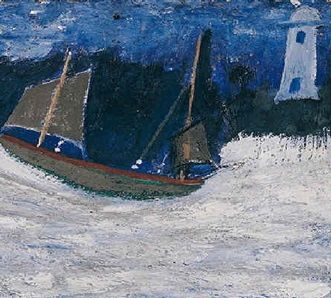
Growing up in extreme poverty, Wallis sent to work on a schooner when he was nine years old. Over the years, Wallis would serve first as a cabin boy and then a cook before becoming a full seaman. According to the artist Sven Berlin, the first person to conduct detailed research on Wallis's life, "it is almost certain he never went to school. What little he knew of reading or writing he taught himself while he was at sea." Still, while the water may have prevented him from obtaining a formal education, it would have a profound influence on the art he would begin to create six decades later.
Early Training
Despite spending much of the year at sea, as a young adult Wallis settled when on dry land in the Cornish town of Penzance, where he briefly shared a home with his brother Charles and Charles's wife. The family dynamic was not an easy one, as Wallis did not get along with his sister-in-law, and the brothers eventually had a falling out. One account has it that Wallis's brother, an alcoholic, tricked him out of an inheritance from a distant maternal uncle. Regardless of the reason, the brothers became estranged, and Wallis never spoke to Charles again.
Mature Period
While living in Penzance, Wallis developed a friendship with a man named George Ward. Desperate for fellowship, Wallis began spending time with Ward's family, and after Ward's father died in 1872, Wallis began a relationship with Ward's mother, Susan. The couple married in 1875 when Wallis was twenty and his new wife forty-one. Susan had already given birth to seventeen children and when they married Wallis became an instant stepfather to her five surviving children (including his best friend, George, who was two years his senior).
While Wallis was away sailing on the Atlantic his wife gave birth to a premature daughter who lived only a few months. Saddened by this loss, and tired of being away for such long periods of time, in 1880 he gave up work on deep-sea boats and took up more local fishing. Not long afterwards a second daughter was born but sadly also died in infancy.
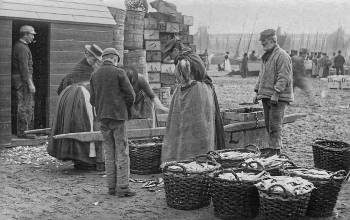
Needing a greater income to support his family, in 1890 Wallis gave up fishing altogether and moved to St. Ives, where he opened a marine rag-and-bone business. He quickly became well-known in the town and, according to Berlin, "brought up scrap iron, sails, rope, odds and ends of all kinds from the boats, and made a regular tour of the town with a sack on his back, calling: 'Rag-a-bone! Old iron! - Old iron! Rag-a-bone!' He became known in the town as 'Old Iron,' and is still remembered as such."
After working in this career for more than two decades, industrial developments and the decline of the Cornish fishing market forced Wallis to close his business in 1912. With the children grown, Wallis and Susan moved to a smaller cottage where he did any work he could to try to scrape by, including, according to the art critic Edwin Mullins, "various odd jobs such as moving furniture and building government huts during the First World War." According to Berlin, one job stands out the most, when Wallis became "the first man in St. Ives to make ice-cream and take it in the streets for sale."
Depending largely on each other in these late years, Alfred and Susan became, according to Mullins, increasingly isolated: "Wallis withdrew into himself keeping company only with Susan, the newspapers and a large black family Bible which he would read aloud on Sundays." Then, on June 7, 1922, Wallis's wife died. The already financially perilous situation in which he had been living was exacerbated when he discovered that the little money he and his wife had managed to save away in their linen trunk had been slowly but completely removed by his stepchildren prior to their mother's death. Left penniless, he disowned his family and became increasingly isolated from the community in which he lived.
Later Period
In 1925, at the age of seventy, Wallis began to paint. There was apparently no single, momentous event that led to this. It is quite likely that loneliness and boredom were the chief causes. Berlin describes how Wallis declared his intentions to a local shopkeeper: "Aw! I dono how to pass away time. I think I'll do a bit' a paintin' - think I'll draw a bit." According to Berlin, he then immediately went into the shop next door to buy brushes and paint, returning to the shop the next day to show the shopkeeper his first works.
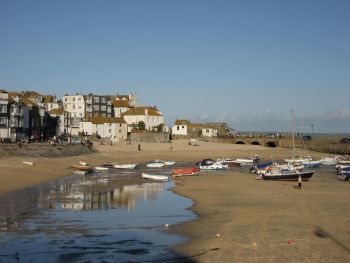
Wallis never showed any interest in becoming a professional artist. With no formal training he seems to have painted mainly to busy his mind, taking for subject-matter the scenes and landscapes that he knew best: oceans, harbors, and the houses and streets of St. Ives.
Despite living near the Porthmeor Art Gallery and a large community of St. Ives artists, Wallis never associated with them. Having often stated, "I am not a real painter," Wallis did not aspire to join the artist ranks. According to Berlin, "the fact that he was always referring to the St. Ives artists as 'real painters' suggests that he had a clear distinction between himself and them from the beginning." Unlike the professionals, Wallis never painted on canvasses, in large part because he could not afford them, choosing instead to paint on materials and surfaces he found in his house, such as irregularly shaped scraps of cardboard, book covers, pieces of wood, his walls, and old glass jars. He never used artist's paints, instead using the hardy, weatherproof paints used to cover ships. This seems to have been a point of pride for Wallis, who once stated, "I don't use the paint artists use; mine's the real paint. Don't want the muck they've got."
Although Wallis was always happy to keep his paintings to himself, in August 1928 two artists, Ben Nicholson and Christopher Wood, noticed his work through the open doorway of his cottage while vacationing in St. Ives. Instantly impressed, Nicholson later recalled that Wallis's paintings had struck him on first viewing as "just like Cézanne." After inviting them into his cottage, Wallis was genuinely surprised when the pair asked to buy some of his paintings. Having never considered a price he simply told them to give him what they wanted. Not only were Nicholson and Wood responsible for Wallis's first professional sale but they also enthused others in their circle about his work upon their return to London, including the art critic Adrian Stokes.
In spite of his adoption by this new circle, Wallis remained stubborn and eccentric in his habits. Notably, when his new friends returned to visit him, he would refuse to sell them his work on a Sunday. As a deeply religious man he believed that it was sinful to do so. He also remained largely impervious to Nicholson and Wood's insistence on the quality of his work, and never fully realized its impact on them, nor on the artistic scene that was gathering in Cornwall, the so-called St. Ives School. Berlin notes that Wallis was more concerned with how the locals in the town felt about him: "he knew people laughed at his work. Having great difficulty in keeping his modest and simple faith in what he was doing, he was over-sensitive of being made a fool of."
Although Wallis was beginning to thrive as an artist he was also becoming more and more solitary and neurotic in his habits. Remaining increasingly alone in his home, he became paranoid, and his strong distrust of the townsfolk led him to believe that they were attempting to poison him. According to Berlin, Wallis was consumed by a "persecution mania." His "mind began to show the first signs of breaking down, and [he] developed what he called his 'wireless brain.' Wireless was becoming popular: to a man so retarded and against civilization and its inventions it could well have seemed an unholy thing [...] Simultaneously with the appearance of wireless he had begun to hear voices when he was alone in his cottage - especially at night: they called him 'a damn Catholic,' 'a Methodist,' 'a thief,' an 'Irishman,' each representing a different religious body, trying to drag him away from his own belief in the Bible. The rooms upstairs, which he had not entered since Susan's death - save to hang up his washing - was taken over by the Devil: it was from here the messages were sent down at night. They also came down the chimney." When this occurred Wallis would sometimes lock himself in his cottage, screaming so loudly that he would disturb his neighbors, while on other occasions he would ask one of his few friends to come and help him get them out of his house. Berlin describes how these friends would enact a routine of walking through the rooms and removing the 'wires', although after a period they would inevitably return, and the process would begin again.
Then, at some point in 1936 or 1937, Wallis was involved in an accident, which he later described as being "knocked down by a car in the street." Wallis did not believe that the incident was chance and, though his paranoia around it was imprecise, his general sense of unease increased. According to Berlin, "he was very badly shaken up and was never quite the same man afterwards [...] Moreover, he was treated shabbily over this. Very little notice was taken by the occupants of the car at the time of the accident, and no one troubled to call on him afterwards to see how he was. In his own mind he looked upon this as another manifestation of the satanic aggression which was destroying his life."
Eventually, Wallis's mental health proved completely debilitating. He lived in an increasing degree of squalor and his cottage became infested with fleas. He also ate very little. Concerned neighbors called a doctor, who after diagnosing him with bronchitis, reported his living conditions to the authorities. This, coupled with the report of a pension officer who was sent by Wallis's nephew in an attempt to grant him a pension, resulted in Wallis being certified as unfit to live independently. In June 1941 he was sent to the Madron Public Assistance Institution. His greatest fear in later life was that he would be sent to a poorhouse, and that is exactly what happened.
Life at Madron, a small village in West Cornwall, near St. Ives, was dire. Wallis's mental health deteriorated further, which, together with his failing eyesight, caused him to distrust those around him. Still, he did receive visits from Nicholson and Stokes, and with their encouragement he painted as much as he could to pass the time. By this point, however, his paintings had taken on a much darker tone.
After a long and often tormented life, Wallis died in Madron in 1942. Stokes arranged for a coffin and a Salvation Army funeral for Wallis, saving him a pauper's burial - the fate that befell most poorhouse residents. In an act of tribute, the modernist poet W.S. Graham wrote an epitaph for the artist entitled "The Voyages of Alfred Wallis."
The Legacy of Alfred Wallis
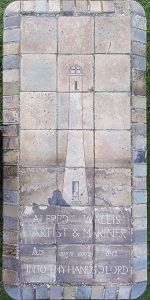
Alfred Wallis's work does not just offer us a thematic portrait of the life of a mariner and working-class tradesman in late-nineteenth and early-twentieth-century Cornwall. It also offers us glimpses into the emotional content of his character and of his interaction with the worlds in which he moved. Objects in his paintings, from fish to boats to houses, seem to expand or diminish based on their significance to the artist, while his paintings adopt by spontaneous instinct the same multifocal perspectives that Cubist artists such as Paul Cézanne had pioneered.
It was this untutored vision that impressed highly tutored visitors such as Ben Nicholson, who at the time of his first meeting with Wallace was pioneering the development of British Constructivism and would later become - like Wallace himself - a figurehead of the St. Ives School. Wallace's work is now seen as amongst the most important products of that school, though it is a poignant footnote to this story that he never appreciated nor materially benefited from his celebration.
Nonetheless, in retrospect, Wallace can be seen to have challenged the distinctions between high and low art which were both undercut and reinforced by the modernist period. Living and painting in the midst of what was becoming a coterie of feted artists, he refused to interact closely with them or to engage with their accounts of his work. He never adopted the techniques or materials of a professional artist, creating paintings on every surface but canvas, and continuing to work with weatherproof boat paints rather than artists' pigments up until the end of his life.
Wallis found fame during the first flushes of Outsider Art, a new phenomenon within the art world codified after the Second World War by Jean Dubuffet through the concept of Art Brut. In Wallis the St. Ives group found an oracle of untaught genius. Whether this adoption of his personality and work was admirable or a form of cultural appropriation, Wallis provided much of the framework for our modern understanding of the Outsider Artist, predicating the narratives which surround artists such as Bryan Pearce.
Whatever the terms of their engagement with his work, there is no doubting Wallis's deep and genuine influence on the artists who discovered him, Ben Nicholson and Christopher Wood. According to Sven Berlin, the influence on Nicholson was especially profound, and "is most markedly seen in the Cornish landscapes."
Influences and Connections

-
![Barbara Hepworth]() Barbara Hepworth
Barbara Hepworth -
![Ben Nicholson]() Ben Nicholson
Ben Nicholson -
![Christopher Wood]() Christopher Wood
Christopher Wood - Margaret Mellis
![Herbert Read]() Herbert Read
Herbert Read- H.S. Ede
- Adrian Stokes
-
![Naum Gabo]() Naum Gabo
Naum Gabo -
![Barbara Hepworth]() Barbara Hepworth
Barbara Hepworth -
![Ben Nicholson]() Ben Nicholson
Ben Nicholson - Peter Lanyon
- Margaret Mellis
![Herbert Read]() Herbert Read
Herbert Read- H.S. Ede
- W.S. Graham
- Adrian Stokes
 Ask The Art Story AI
Ask The Art Story AI